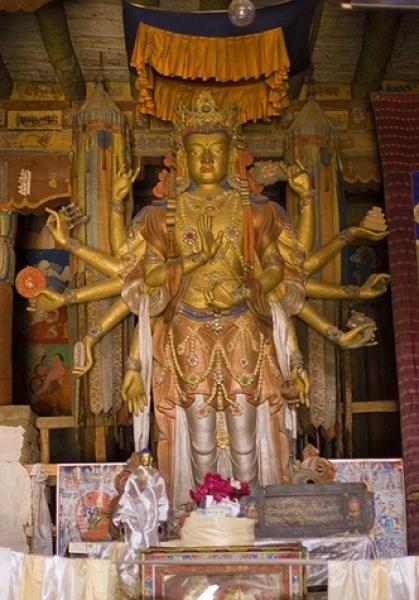“Ladakh”
As soon as you read the name, the thoughts of the barren mountains, the famous lake – Pangong Tso, and the highest passes come to one’s mind. Well, Ladakh is just more than that; it is filled with rich tangible and intangible cultural heritage, the natural scenic beauty, colorful mountains, the influence of Tibetan Buddhism culture and much more.
Ladakh is a treasure account of many battles and wars. One of the important expedition of Ladakh occurred, some 200 years ago by General Zorawar Singh. A fort which proves to be the evidence of this invasion still stands in the cold and barren desert of Leh Ladakh – built by Zorawar Singh in 1836 and manned by his commander Mehta Basti Ram. This fort is known as Riasi Fort and the position of this fort is exactly above Leh Palace and Namgyal Tsemo Gompa. (Feature Image, Image 1, Image 2 & Image 3)



So who was this General Zorawar Singh? What importance does he hold in Indian History? Was he an invader or a brave soldier? A lot of questions arise when we study about this brave warrior. As we start flipping the history textbooks we start finding the answers to the above questions. The records of General Zorawar Singh are the most thrilling episodes of Indian History. (Feature Image, Image 4 & Image 5)

If it wouldn’t have been General Zorawar Singh, today Jammu and kashmir would have been parts of Afghanistan or some parts of China. The flutter of a conquest or a treaty 200 years ago creates a storm in the present day, to rephrase a popular saying.

Zorawar Singh Kahluria was born at Kahlur, in today’s Himachal Pradesh in the late eighteenth century. This was the time when the sun of the Sikh empire had begun to rise with the conquest of Lahore by Maharaja Ranjit Singh also known as ‘Lion of Punjab’. A young Zorawar Singh soon found himself in the great king’s army. In 1834, with Sikh rule in Punjab and Jammu firm and strong, he was sent on an expedition into Leh and Ladakh – which involved crossing the Lanvila Pass at over fourteen thousand feet! He led the expedition via Kishtwar, Dachin, Marwah, Warwan and then Lanvila pass. He constructed forts at Suru and Leh Valley for administration purposes. (Feature Image, Image 4, Image 5 & Image 6)

In 1835 he returned back to Kishtwar, till then a rebellion broke out and thus in order to suppress this protest he immediately turned back and took a shorter route but a hard one via Umasi La Pass which is supposed to be seventeen thousand feet to Zanskar and Leh where he reached in just ten days. Lets not forget that this expedition was taking place in nineteenth century, where in a region even today with modern technology reaching to this height is difficult and outsiders struggle to acclimatize and breathe adding to this was that this all was happening in the month of November. This incident marks as a record in the annals of the world military history.
Inclusion of Ladakh in Maharajah Ranjit Singh’s territory is of significant geo-political importance for the present day India. If not for the success of this expedition, with China’s conquest of Tibet in 1950, today it would be a part of China. (Image 7 & Image 8)


In 1840, General Zorawar Singh turned towards Baltistan which is situated in Karakoram range to the south of K2 mountain, the second tallest mountain in the world. This is the place where Dard tribe live; they are said to be the descendants of the soldiers of Alexander the Great. This expedition helped in Baltistan to become a part of Punjab province nor today it would have been a part o Afghanistan as it was ruled by Afghan chief Ahmad Shah Durrani at that time.(Image 9 & Image 10)


After the conquest of Baltistan, in 1841,General Zorawar Singh moved his attention towards the ‘roof of the world’ which led him to the Western Tibet. Crossing Pangong Tso lake at 14,300 feet, at the Ladakh – Western Tibet border, he travelled via Guge kingdom, Tholing, Purang to Mount Kailash and Mansarovar. In the month of August 1841, a fight broke out between the two and both the sides suffered human loss, but the Tibetan could not stand Dogra onslaught and fled towards. Taklakot. After some feeble resistance, in Sept 1841, the Dogras took possession of Taklakot. Zorawar Singh’s conquest of western Tibet was now complete.(Image 11, Image 12 & Image 13)



The Dogras, under General Singh were not allowed to reap the fruits of their new conquests in Western Tibet. Lhasa provided reinforcement to General Pishi, about 10000 Tibetan army to fight back the invaders. Meanwhile, the winter had set in and the heavy snow fall had closed mountain passes. The Tibetan army invaded Taklakot in early November and also surrounded the other Dogra military posts. On Dec 12, Zorawar Singh was hit on the right shoulder and he fell down from his horse near the village Do-yo, but he did not give in putting to death many of his enemies with the sword in his left hand, although badly wounded. However, he was killed by a Tibetan warrior on December 12, 1841 in the vicinity of Taklakot.(Image 14)

After 1841. within the span of a few years, the Sikh empire had lost all three of its greatest personas – Hari Singh Nalwa, Maharaja Ranjit Singh and Zorawar Singh Kahluria. Thus the gates slowly got opened for the British Empire.
General Zorawar Singh has always earned the respect of both the victorious friend and the vanquished foe. In battle he fought to defend the values of life as enshrined in our Dharma. His honesty and integrity went unchallenged till his last breath.

In books of history and research papers, General Zorawar Singh is rightly called : Napoleon of India.
Written by – Ishwari Khandelwal, studio adda research intern

